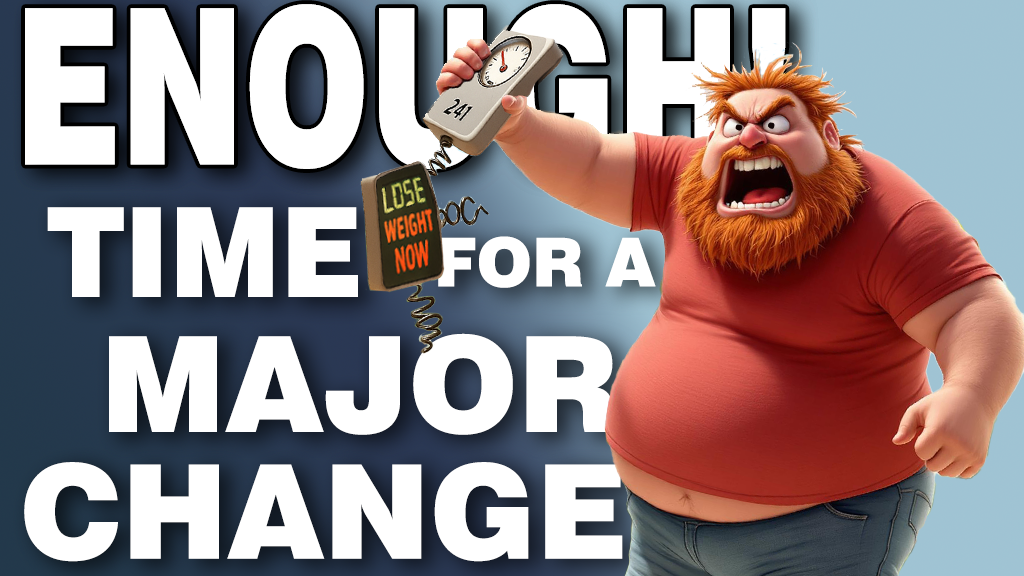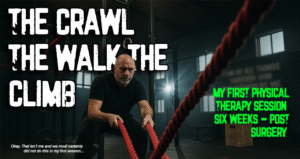Surgery was the beginning of change for me.
There it was—right there on the scale. A number I had never seen before on any scale I’d ever stepped on:
241
For me, that number was—and still is—unacceptable. Am I a professional athlete? No. And if I was, that weight would only make sense if a massive amount of muscle came with it.
The surgeon’s assistant tried to wave it off:
“Oh, our scale isn’t always accurate.”
I laughed.
“Oh no. That’s me. And that’s unacceptable.”
The Warning I Couldn’t Ignore
The real kicker came minutes later.
First time meeting the surgeon. First consult. We hadn’t even scheduled anything yet, and he looked me straight in the eye and said:
“I think surgery is the right solution for you. But… you’re carrying a lot of extra weight. It could cause complications, and it will slow your recovery.”
I wanted to be mad.
But he was right.
I had let myself gain 60 pounds since my in-shape days. And I knew it.
The mirror lied just enough to let me hide. But videos and photos?
Those told the truth. I hated what I saw. The shape I was in didn’t reflect the man I believed myself to be—or the life I wanted to live.
I think we’re pretty good at lying to ourselves. And I’m very good at it.
I could still see the “me I used to be” inside that reflection—so I got real good at excusing it all away.
“I’m not that far off.”
But 60 pounds is far off—for me.
Post-Surgery Me Was Hungry… for Change
(See what I did there?)
The surgery went well. It fixed the mechanical issue.
There was a real problem that the weight wasn’t helping—but it didn’t necessarily cause it either.
However, fixing the weight issue?
That’s a different kind of surgery. Or what makes more sense… a huge lifestyle change.
That part was on me. So I made a decision. I’m changing.
It’s time to lose the weight.
I decided to rebuild—not bounce back—and I wasn’t going to do it blindly.
I asked my surgeon for a starting point. He recommended a keto-style approach, at least to begin with. Then shift once the results start rolling in. He actually took the time to talk nutrition with me—way more than I expected. That stuck with me.
Then I fired up ChatGPT.
And I began a relentless, honest, open-ended conversation with AI. I set up a whole nutritionist mode and created different chat threads: nutrition coach, accountability partner (whole other blog post coming), meal planner, cooking strategy… yeah, I nerded out.
I may have gone a little overboard. But I’m off work for a few months recovering—and I’ve got time.
We talked macros. Cravings. Keto. Blood sugar. Energy crashes. Meal prep. Cooking styles. You name it.
That’s how I landed on the plan you’ll see all over this site.
Not a gimmick. Not a 30-day fix.
This is a partnership—me, my body, and this strange-but-smart tool called AI—building a new lifestyle one step, one meal, one rep, and one honest reflection at a time.
Where I Am Today
As I’m writing this, I’m down nearly 10 pounds.
That’s not an ad.
That’s not a sales pitch.
That’s me—one month post-op—waking up every day trying to be 1% better.
It’s slow.
It’s frustrating.
But it’s happening.
And the best part?
You’re invited into it.
Before it’s polished. Before it costs anything. Before I even know if it fully works.
[Check out the free cookbook.]
(Hey—it’s free, so no, it’s not polished yet. Still in progress.)
Maybe it gives you some ideas to build your own plan.
Maybe you jump on this one and see where it takes you.
Maybe you just stick around and watch.
But let me ask you this:
How mad will you be at yourself if, three months from now, I’ve dropped a bunch of weight with this plan… and you’ve done nothing differently?
I can tell you from experience:
You WILL be mad.
Know your outcome. Take action.




